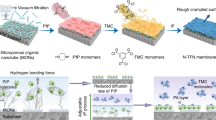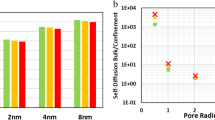Abstract
Over the past decade of nanotube research1, a variety of organized nanotube architectures have been fabricated using chemical vapour deposition2,3,4,5. The idea of using nanotube structures in separation technology has been proposed6,7,8, but building macroscopic structures that have controlled geometric shapes, density and dimensions for specific applications still remains a challenge. Here we report the fabrication of freestanding monolithic uniform macroscopic hollow cylinders having radially aligned carbon nanotube walls, with diameters and lengths up to several centimetres. These cylindrical membranes are used as filters to demonstrate their utility in two important settings: the elimination of multiple components of heavy hydrocarbons from petroleum—a crucial step in post-distillation of crude oil—with a single-step filtering process, and the filtration of bacterial contaminants such as Escherichia coli or the nanometre-sized poliovirus (∼25 nm) from water. These macro filters can be cleaned for repeated filtration through ultrasonication and autoclaving. The exceptional thermal and mechanical stability of nanotubes, and the high surface area, ease and cost-effective fabrication of the nanotube membranes may allow them to compete with ceramic- and polymer-based separation membranes used commercially.
This is a preview of subscription content, access via your institution
Access options
Subscribe to this journal
Receive 12 print issues and online access
$259.00 per year
only $21.58 per issue
Buy this article
- Purchase on Springer Link
- Instant access to full article PDF
Prices may be subject to local taxes which are calculated during checkout




Similar content being viewed by others
References
Dresselhaus, M.S., Dresselhaus, G. & Avouris, P. Carbon Nanotubes: Synthesis, Structure, Properties and Applications (Topics in Applied Physics Series, Springer, Heidelberg, 2001).
Li, W.Z. et al. Large scale synthesis of aligned carbon nanotubes. Science 274, 1701–1703 (1996).
Ren, Z.F. et al. Synthesis of large arrays of well-aligned carbon nanotubes on glass. Science 282, 1105–1107 (1998).
Huang, S.M., Dai, L.M. & Mau, A.W.H. Controlled fabrication of large-scale aligned carbon nanofiber/nanotube patterns by photolithography. Adv. Mater. 14, 1140–1143 (2002).
Wei, B.Q. et al. Organized assembly of carbon nanotubes. Nature 416, 495–496 (2002).
Hinds, B.J. et al. Aligned multiwalled carbon nanotube membranes. Science 303, 62–65 (2004).
Casavant, M.J., Walters, D.A., Schmidt, J.J. & Smalley, R.E. Neat macroscopic membranes of aligned carbon nanotubes. J. Appl. Phys. 93, 2153–2156 (2003).
Miller, S.A., Young, V.Y. & Martin, C.R. Electroosmotic flow in template-prepared carbon nanotube membranes. J. Am. Chem. Soc. 123, 12335–12342 (2001).
Long, R.Q. & Yang, R.T. Carbon nanotubes as superior sorbent for dioxin removal. J. Am. Chem. Soc. 123, 2058–2059 (2001).
Yan-Hui, L. et al. Adsorption of fluorine from water by aligned carbon nanotubes. Mater. Res. Soc. Bull. 38, 469–476 (2003).
Kalra, A., Hummer, G. & Garde, S. Methane partitioning and transport in hydrated carbon nanotubes. J. Phys. Chem. B. 108, 544–549 (2004).
Skoulidas, A.I., Ackerman, D.M., Johnson, J.K. & Sholl, D.S. Rapid transport of gases in carbon nanotubes. Phys. Rev. Lett. 89, 185901 (2002).
Kyotani, T., Mori, T. & Tomoita, A. Formation of flexible graphite film from poly (acrylonitrile) using layered clay film as template. Chem. Mater. 6, 2138–2142 (1994).
Stikkers, D.E. Octane and the environment. Sci. Total Environ. 299, 37–56 (2002).
Albahri, T.A., Riazi, M.R. & Alqattan, A.A. Analysis of quality of petroleum fuels. Energ. Fuel. 17, 689–693 (2003).
Collee, J.G., Fraser, A.G., Marimion, B.P. & Simmons, A. Mackie and McCartney Practical Medical Microbiology (Churchill Livingston, New York, 1996).
Putnak, J.R. & Phillips, B.A. Picormaviral structure and assembly. Microbiol. Rev. 45, 287–315 (1981).
Phillips, B.A. In vitro assembly of polio-virus. II Evidence of the self-assembly of 14S particles into empty capsids. Virology 44, 307–316 (1971).
Hogle, J.M., Chow, M. & Filman, D.J. Three-dimensional structure of polio virus at 2.9A resolution. Science 229, 1358–1565 (1985).
Chwickshank, R., Duguid, N.P., Marmion, B.P. & Swain, R.H.A. Medical Microbiology (Churchill, London, 1975).
Acknowledgements
This work was partly funded by the Ministry of Non-Conventional Energy Sources and the Department of Science and Technology (New Delhi). A.S. acknowledges a fellowship from the Council of Scientific and Industrial Research. We are thankful to A. S. K. Sinha, A. K. Gulati, P. Ramachandra Rao and G. Nath of Banaras Hindu University, Varanasi, India for providing facilities, help and discussions. We thank A. D. Migone for sharing the results of adsorption measurements prior to publication, A. Cao and Ray Dove for help with the TEM images and Donald R. VanSteele for help with the mechanical strength characterizations. S. T., P. M. A. and R. V. acknowledge funding support from the Rensselaer Polytechnic Institute, National Science Foundation, Nanoscale Science and Engineering Center and Philip Morris USA.
Author information
Authors and Affiliations
Corresponding authors
Ethics declarations
Competing interests
The authors declare no competing financial interests.
Supplementary information
Rights and permissions
About this article
Cite this article
Srivastava, A., Srivastava, O., Talapatra, S. et al. Carbon nanotube filters. Nature Mater 3, 610–614 (2004). https://doi.org/10.1038/nmat1192
Received:
Accepted:
Published:
Issue Date:
DOI: https://doi.org/10.1038/nmat1192
This article is cited by
-
Carbon Nanomaterials: Fullerene to Graphene
Transactions of the Indian National Academy of Engineering (2022)
-
A cohesive effort to assess the suitability and disparity of carbon nanotubes for water treatment
Environmental Science and Pollution Research (2022)
-
Engineered nanomaterials for biomedical applications and their toxicity: a review
Environmental Chemistry Letters (2022)
-
Recent Advances of Nanotechnology in Mitigating Emerging Pollutants in Water and Wastewater: Status, Challenges, and Opportunities
Water, Air, & Soil Pollution (2022)



